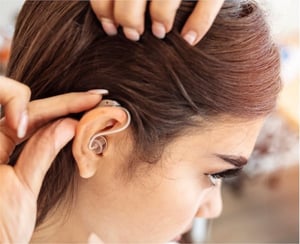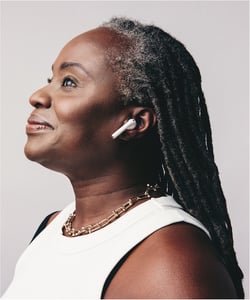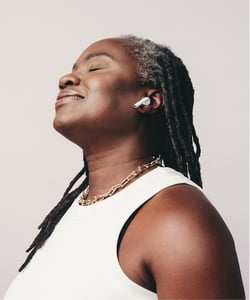
We think of audio technology primarily as a means of entertainment, but the recent release of guidelines for over-the-counter (OTC) hearing aids from the U.S. Food and Drug Administration (FDA) spotlights the potential audio has to improve health and quality of life. Companies are moving forward with new digital technology that can not only improve hearing for millions of people but can also improve their mental health and allow them to remain happy and productive as they age. And it’s not just in hearing aids—it’s even in mainstream consumer audio products you can find at big-box retailers or on Amazon.
Because modern life frequently exposes us to loud noises, hearing loss has been increasing. According to “Addressing Estimated Hearing Loss in Adults in 2060,” a 2017 article from Journal of the American Medical Association:

 The effects of hearing loss are only now starting to be fully appreciated. According to audiologist Dr. Julie Glick, Au.D, of Musicians Hearing Solutions in Los Angeles, “Hearing loss can cause a whole host of issues most people don’t realize. It can lead to depression and cause people to isolate. If you know a social event is going to be in a noisy environment, where you’ll have trouble understanding conversations, you may choose not to go. Or you may not want to ask people to repeat their statements, so you end up agreeing to things you didn’t realize you were agreeing to.”
The effects of hearing loss are only now starting to be fully appreciated. According to audiologist Dr. Julie Glick, Au.D, of Musicians Hearing Solutions in Los Angeles, “Hearing loss can cause a whole host of issues most people don’t realize. It can lead to depression and cause people to isolate. If you know a social event is going to be in a noisy environment, where you’ll have trouble understanding conversations, you may choose not to go. Or you may not want to ask people to repeat their statements, so you end up agreeing to things you didn’t realize you were agreeing to.”

Glick also points out that studies show hearing loss is associated with dementia. Indeed, the paper “Dementia Prevention, Intervention, and Care: 2020 report of the Lancet Commission,” reported that hearing loss was identified in 31.7% of cases of dementia among patients aged 45 to 65—even though only 5.3% of people in that age group suffer disabling hearing loss. The study also found that the use of hearing aids is associated with decreased incidence of dementia in those with hearing problems and is the largest factor protecting from decline.

Troubling as these statistics are, few of those suffering hearing loss seek treatment; according to a report in Archives of Internal Medicine, 86% of people over 50 with hearing loss do not use hearing aids. Stated reasons include the high cost of audiologist-supplied hearing aids (which are often not covered by insurance), the complexity of fitting and tuning the hearing aids, and perceived social stigma around the use of hearing aids.

Fortunately, the Over-the-Counter Hearing Aid Act, passed by the U.S. Congress in 2017, has inspired audio companies to develop new technologies intended to make these products more popular and effective. Many companies, including Eargo, NuHeara and Olive Union are helping hearing-loss sufferers treat their problem without going to an audiologist; they’ve created technologies that allow an app to automatically test a user’s hearing in minutes, then upload a correction curve to tailor the device’s response to the user’s hearing.
Other companies, such as Audiodo, Bose, Mimi and Sonarworks, are now licensing these technologies, so they can be added not only to hearing aids, but also to headphones and earphones. We’re already seeing consumer products from such companies as 1More, Beyerdynamic, Monoprice and PSB that incorporate these technologies—even in earbuds priced as low as $69. Some of these products are intended only for music listening, while others can function as hearing aids. Either way, they can help users who are reluctant to be seen wearing hearing aids ease their way into treating their condition, using products similar to those they probably already own.
These technologies can also employ digital processing to focus the response of hearing aids and other products, so that the listener hears more of what’s in front of them, such as a person speaking to them, and less of the surrounding noise and chatter. Advanced products, such as Starkey’s Livio AI hearing aids, can even track mental and physical fitness and translate foreign languages in real time.


These hearing enhancement technologies can make life much better for the estimated 430 million people worldwide suffering from hearing loss. They can help hard-of-hearing people carry on normal conversations again, thus encouraging social engagement and reducing the chance that a person’s hearing problem will lead to depression or dementia. They can also help people enjoy music and movies more, because they’ll be able to understand vocals and dialogue better.
The audio industry is also working to reduce hearing loss in the first place. Many headphone users regularly listen at levels as high as 95 decibels, which can damage their hearing in less than one hour. Some headphone makers have been working to limit the maximum volume of their products, but with wired headphones, this is difficult because they don’t know the power or gain of the amplifier the headphones are connected to. But the digital audio processing incorporated into most Bluetooth headphones makes it possible to precisely limit volume to safe levels — typically 85 decibels, a level considered by the National Institute for Occupational Safety and Health (NIOSH) to be safe for up to eight hours of continuous exposure. The same digital processing also makes it possible to add features such as noise canceling and loudness compensation, which can reduce noise interference and tailor the sound to make listening at safer levels more enjoyable.

With so much effort now being devoted to preserving and improving the ability of people to hear clearly, audio is rapidly becoming more than a means of communication and entertainment. We can now think of it as a way to improve people’s lives—not only while they’re listening to music and movies, but every waking minute of their lives.
